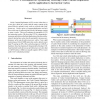Free Online Productivity Tools
i2Speak
i2Symbol
i2OCR
iTex2Img
iWeb2Print
iWeb2Shot
i2Type
iPdf2Split
iPdf2Merge
i2Bopomofo
i2Arabic
i2Style
i2Image
i2PDF
iLatex2Rtf
Sci2ools
DATE
2008
IEEE
2008
IEEE
CATCH: A Mechanism for Dynamically Detecting Cache-Content-Duplication and its Application to Instruction Caches
Cache-Content-Duplication (CCD) occurs when there is a miss for a block in a cache and the entire content of the missed block is already in the cache in a block with a different tag. Caches aware of content-duplication can have lower miss rates by allowing only blocks with unique content to enter a cache. This work examines the potential of CCD for instruction caches. We show that CCD is a frequent phenomenon and that an idealized duplication-detection mechanism for instruction caches has the potential to increase performance of an out-of-order processor, with a 2-way eight instruction per block 16KB instruction cache, often by more than 5% and up to 20%. This work also proposes CATCH, a hardware based mechanism for dynamically detecting CCD. Experimental results for an out-of-order processor show that a CATCH with a 2.32KB cost usually captures 60% or more of the CCD’s idealized potential.
| Added | 29 May 2010 |
| Updated | 29 May 2010 |
| Type | Conference |
| Year | 2008 |
| Where | DATE |
| Authors | Marios Kleanthous, Yiannakis Sazeides |
Comments (0)

